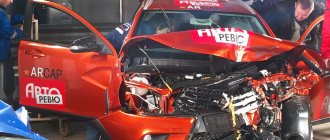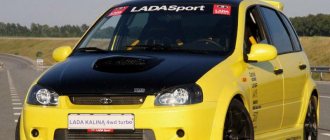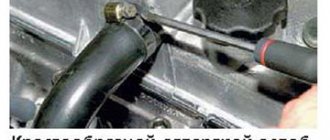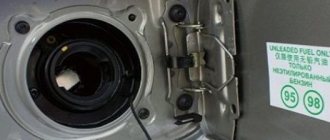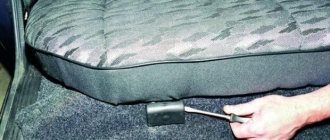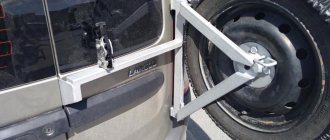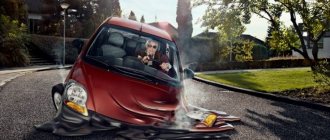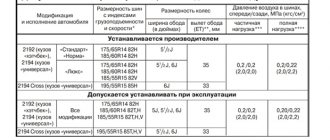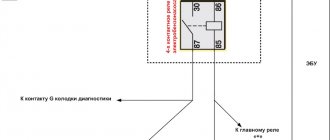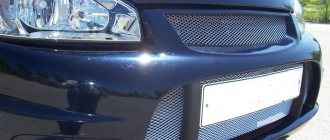Testing methodology
The car in question was destroyed in just one crash test. It was a frontal impact with a 40 percent overlap, and the car itself was accelerated to 64 km/h. Let us clarify once again - here we are talking about equipment 21942-42, equipped with pyrotechnic belt pretensioners. The wheels in this configuration are made of light alloy, which, in turn, could also affect the result.
Station wagon Kalina-2 Lux, photo from the official website
After gaining speed, the station wagon body encounters an obstacle that covers 40% of the space and is located on the driver’s side. This method of testing a car is close to the EuroNCAP methods used for a long time in Europe. What happened as a result is described in the next chapter. In fact, the Lada Kalina car received 3 stars out of 4 possible, which is not so bad. The Granta in the sedan body did not earn much more points, but it was tested using a similar method.
EuroNCAP safety testing standard
The EuroNCAP vehicle safety standard is considered the most authoritative in the automotive world.
The fact is that it is recognized in almost all countries of the European Union, and this is a good half of the global automobile market. The assessment of new automobiles using this method has been carried out since 1995, and the mandatory conduct of such studies is established for new car models directly in a number of European directives.
According to this standard, not only passive, but also active safety is tested. At the same time, the rating system is constantly being improved and updated with new safety indicators.
This rather strict rating system has earned recognition throughout the automotive world, and other safety ratings were created on the basis of EuroNCAP, for example the Russian ARCAP. It is the European rating that most car dealers or regulatory authorities rely on when recognizing a particular vehicle as safe for use.
As for the EuroNCAP test of Russian cars, for example, the Lada Kalina Cross was tested by the manufacturer using its own methodology, which was included in the European test, but did not fully comply with it.
As a result, it was revealed that in the event of a frontal impact, the dummies do not receive damage, and in the event of a rollover, fuel does not leak from the car.
Since no official EuroNCAP tests have been carried out, the off-road version of Kalina may experience difficulties selling it abroad. Russian car enthusiasts should keep in mind the fact that the manufacturer tested its products independently. Therefore, he himself will have to determine the reliability of this test before purchasing this station wagon crossover.
tweet
back How to train a Lada Kalina key
Next Instructions for replacing the thermostat on Lada Kalina
TagseuroNCAP, safety, test, crash test
Test result
It can be stated that in Kalina-2 with an automatic transmission, the driver’s shins may suffer. The head of the mannequin, which was in the driver's seat, also received serious mechanical stress. But the passenger, who was on the right side of the driver, was fine after the impact. The following diagram illustrates the words:
One dummy was damaged after a frontal impact
Let us clarify what exactly we were able to observe from the test results:
- The brake pedal offset into the cabin is 141 mm;
- Steering wheel offset – 98 mm;
- Change in the geometry of the doorway on the left (maximum value) – 55 mm.
Now let's look at what happened to the mannequins.
| Type of damage | Implications for the driver | Passenger value |
| Head Injury Index (HIC) | 540 | 340 |
| Bending moment of forces acting on the neck, Nm | 28 Nm | 15 Nm |
| Rib compression, mm | 28 mm | 22 mm |
| Load on the femur, kN | 1.5 kN | 1.2 kN |
| Shin injury rate | 0,72 | 0,3 |
The question remains of how the load on the mannequin’s head changed from second to second. The answer looks like this:
Head load for passenger and driver
The minimum acceleration at which a concussion is recorded is 90-100 g. In general, a trip on Kalina-2 does not threaten anything like this, unless you exceed the speed limit.
Even with concussions, loss of consciousness is rare. However, these words are not a reason for violating the speed limit.
Now let’s compare the obtained figures with the crash test result of another car – the Lada Granta Standard. The rate of damage to the lower leg, for example, turns out to be lower there than indicated in our table. Its value is 0.52 for the driver and 0.41 for the passenger. Perhaps the presence of automatic transmission in LADA cars makes its own adjustments.
Lada Kalina crash test: expectations and hopes
What to expect from a car that is the latest model from a manufacturer that was developed using computer simulations.
Last year, the manufacturer predicted three stars for his invention based on the EuroNCAP rating. This means that testers may believe that the new car is no worse than the foreign Renault Logan. But the manufacturer, who came to crash test the Lada Kalina, for some reason looked clearly upset.
At first glance, the wrecked car could be assessed quite well. The body was not greatly deformed. But the pillar and windshield were already more deformed than those of a foreign car, and the door on the driver’s side broke completely, which is why the doorway was shortened by 80 centimeters, but Logan’s doorway was shortened by only 15 millimeters. But the door of our car opened quite easily, not like that of a foreign car.
Nothing terrible was noticed in the cabin if you lowered the distorted rim of the steering wheel. The front panel remained virtually unchanged, only the shoe deflectors were damaged by the dummy’s hand, and the dummy’s knee damaged the plastic cover of the steering column, a large piece of plastic came off it. The steering wheel has moved only 70 millimeters, which is very good. The pedals also barely moved. The manufacturer is great, he can do it if he wants.
In simple terms and judging by how the body behaved when it received a displaced impact at a speed of 64 kilometers per hour, the car can be called quite modern. Despite the fact that the manufacturer made more than one decision related to the layout and design of the body, as well as other components the car inherited from its predecessors developed twenty years ago, the car still became modern.
What's the best way to transport children?
Let’s say that a cradle belonging to the “0+” category (0-13 kilograms) is attached to the rear seat using an ISOFIX mount. And the child car seat, in which the dummy of a three-year-old child is placed, can then be secured on the other side of the seat.
A forward-facing car seat must be secured using a standard belt, and the dummy of the second baby is placed in the cradle. The Autoreview specialists did exactly what is said here, and during the crash test they were able to obtain the following results:
| Type of damage | Carrycot “0+”, ISOFIX | Forward facing car seat |
| Head overload, g (for 3 ms) | 35.9 g | 80.5 g |
| Chest overload, g (within 3 ms) | 27.2 g | 52.3 g |
| Bending moment of forces acting on the neck, Nm | 15.3 Nm | 27.2 Nm |
Note that the ISOFIX mount has been damaged:
ISOFIX latches in Kalina-2 on the right side
However, this mount coped with its task. The cradle, rigidly fixed with latches, did not change its position after the impact. Therefore, the load that fell on the dummy of the “younger child” did not exceed dangerous limits. However, the 3-year-old mannequin was also not seriously injured. But the load on his head exceeded 80 g, although this part itself did not touch the front seats.
It is believed that for the age group “3 years and older” the g-force can be 87 g. Then there is the possibility of a concussion. This is the standard value officially adopted by the EuroNCAP committee.
The soft fastening used in the experiment contributed to the movement of the car seat forward. This made it possible to reduce the acceleration applied to the dummy. It would have looked worse with snap mounts. If there is no additional neck support, and the car seat itself is installed in the direction of travel, it is better to secure it not with latches, but with belts. The conclusion follows from the crash test results.
It would seem that there is no particular point in using ISOFIX latches from a safety point of view. But there are values obtained during tests of another LADA car, where the cradle was secured with standard belts. So, all the overload values ended up being worse than those indicated in the table, and the difference was 15-25%. Draw conclusions.
Why does a car have to undergo a crash test?
But the car doesn’t even suspect that no one is going to break it, they just want to check its operation.
But after a review of this car was published, with all the colorful descriptions of all the impressions that remain from the car, for example: Sounds, vibrations, smells, the manufacturer asked the testers not to take this car for a test run and to abandon this idea.
They said that this car should not have been tested at all. The first batch of cars was generally made using bypass technology, and they arrived at the dealership only to see if the car was in demand. And dealers took test cars and released them for sale, and they were still so expensive. Well done to the dealers, they tried not to miss anything and made a profit.
The testers made a promise to the manufacturer that they would send this car for crash tests, and for running-in they would take a car from another batch.
Lada Kalina crash test: what did the dummies say?
But the fact that everything is in order with the silt frame of the body is still half the battle.
A little later, specialists deciphered the information from the sensors that were installed on the mannequins. And it became clear why the manufacturer was so sad and sad when looking at the Lada Kalina crash test. The dummy hit his head on the steering wheel with great force, which shocked the testers.
And what’s worse, in the three saving milliseconds that, according to doctors, are needed to ensure that the overload does not affect the human brain, the pressure on the mannequin was twice as high as permissible. These figures are several times higher than those of a foreign car similar to Kalina. Experts have dispelled any remaining doubts that the mannequin suffered a brain injury incompatible with life. Because the injury rate was doubled. Such a sad outcome of the car test. Even when testers conducted tests with Slavuta, its results were lower, and a person involved in an accident had a chance to survive, but in our case there is none.
The minimal injury the dummy suffered during the test was a concussion. Moreover, considering that a mannequin and a person are very different. Indeed, in a real emergency situation, a living person, and not a dummy, will hit his head on a hard plastic steering wheel, and therefore the results will be truly disastrous.
And these are not all the negative factors that this car has. When the dummy who was sitting behind the wheel hit his head on the steering wheel, his head was thrown back so that the sensor located on the cervical vertebra recorded that two out of three parameters were exceeded, the spine was stretched due to the fact that a strong bending moment acted on it. And the severely deformed chest of the mannequin will complement the picture of the injury. The deformation was 50 millimeters. This mark is exactly in the life-threatening zone.
Considering all this, the low load on the knees and shins is pleasing, and it is also pleasing that the pedals have moved only a little, which means that foot injuries have been avoided, but still these characteristics are too few, the overall impression is already spoiled. Although this is also very important. Exactly the same as the fact that the dummy in the passenger seat did not receive any dangerous injuries - he hit his head on the front panel. But still, speaking about the seatbelt passenger of this car, to say that he does not risk getting injured is to say nothing, because the tilt of his head upon impact reaches a critical point, and his chest is also deformed from the fact that he pressed hard on it seat belt, but this injury rate is not too high. A person in such a situation would probably suffer a couple of broken ribs.
How does this whole system work?
The car, along with the fastened dummies, went for a test, and, bouncing off a collision with an obstacle, stalled. The cabin is filled with thick white smoke that has a pungent, unpleasant odor because the squibs went off; by the way, in Logan this smoke is practically odorless. The steering wheel in the cabin has moved quite a bit, the front panel has also been practically unaffected by the collision, and the driver's door also opens easily. The body was practically not deformed, just like the car that passed the first test. But there are also similarities: the door broke just like the first time, despite the fact that the security design has improved. If you count the test scores according to the rules, then you need to subtract one point for this.
What about airbags? Now the dome of each of the pillows, which were sewn using durable polypropylene fabric, is empty. But in the high-speed video footage, we can see how both airbags worked as expected: The driver's airbag popped out 25 milliseconds after the collision occurred, and the passenger's airbag a little later. By the time the mannequin's head touched it, it was open and the blow had softened. Head injuries were reduced to less than normal levels, and the passenger was generally in a safe zone. This is, of course, very good. But why did the steering wheel become deformed again? Why did the driver's chest suffer slightly less than in the first car, which did not have airbags? That's why this car scored 8.4 in the frontal test, although the results could have been more impressive.
Testers familiarized themselves with the results of five other tests conducted by Avtoliv. Indeed, the dummy did not hit his head on the steering wheel, and the overloads became lower. But two tests gave results that showed data about the dummy hitting the chest with the steering wheel, and there was also a high load on the shins. And the experts' assessment did not give seven points. This means that the results of the domestic car can be called quite good.
Yes, the manufacturer really worked on an export car. They expect to sell 60 thousand copies annually. But why are they sure that Europeans will like this noisy, vibration-laden, and unreliable car? Most likely the situation will develop like this. In about a year they will start to see cars appear for export, which will have modern airbags and engines. But they will not be sold on the Western market. And in Russian? Which Russian would need a car that costs a lot of money, regardless of modern equipment? Although these forecasts may be wrong.
